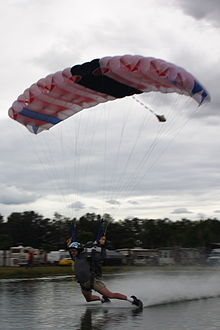Swooping
Swooping [ swuːpɪŋ ] (from English to swoop - " shoot down") (or canopy piloting) is a comparatively young discipline in parachuting , which has become possible through further developments in parachute design . When swooping, sometimes very small (6–10 m² or 65–110 ft²) and agile high-performance parachutes are accelerated by turning. This rotation begins at a height of 200 to 350 meters. The parachutist reaches a vertical speed of 120 km / h and more. The vertical speed recorded in this way is then taken with you in a long, horizontal gliding flight , the "swoop". Depending on the wind strength, the speed is up to 150 km / h directly above the ground.
Swooping is often done over artificial water surfaces called ponds. You can touch the water with your legs and feet, but also your hands. In Germany there is only one Swooppond. This is located in Roitzschjora near Leipzig (Skydive Leipzig). Of course you can also swoop on lakes or above the ground.
Swooping as a competitive discipline
Canopy piloting has now established itself as a competitive discipline. In addition to the annual Open German Championships and World Championships, swooping is also represented at the World Games and World Air Games. Official competitions according to the FAI rules are divided into the disciplines distance, accuracy and (carving) speed. The winner is the jumper with the most points:
Distance : A 1.5 m high and 10 m wide light barrier must be flown through. This so-called entrance gate ("gate") is the zero point. The point of first contact with the surface is counted as the landing point and its distance from the zero point is measured. The current world record is 169.6 m.
Speed : Again the light barrier must be flown through. In this discipline, however, there is now another light barrier in a 75 ° curve at a distance of 70 m. This exit gate must also be flown through. The result of this jump is the time it took to fly through both gates. The current world record is 2.33 s.
Accuracy : Here you have to touch the water to collect points. You can collect points in four places on the water. If you hit all four water gates, you have 100 points. Landing zones are set up behind the water, which together are 34 m long and have a negative point value. You then get the (negative) points for the first touched landing zone. You only get no points deducted in a 2 × 2 m small zone.
Freestyle
Another type of swooping that is particularly spectacular for the public is freestyle swooping. The skydiver can perform pre-determined tricks here while in contact with the water surface. For example, if he leans his upper body forward so that his head almost touches the surface of the water, he does a Superman. If he turns 180 ° in his parachute harness, this is called a blind man. There are other tricks that can be combined with each other. In competition, the degree of difficulty of the trick shown is multiplied by the quality of its execution.
Individual evidence
- ↑ Parachuting at the German Swooping Open , tip Berlin, June 30, 2008
- ↑ CP Events (Illustrated) - Distance ( Memento of the original from March 4, 2016 in the Internet Archive ) Info: The archive link was inserted automatically and has not yet been checked. Please check the original and archive link according to the instructions and then remove this notice. , FAI (English)
- ↑ a b Parachuting World and Continental Records ( memento of the original from June 29, 2015 in the Internet Archive ) Info: The archive link was automatically inserted and not yet checked. Please check the original and archive link according to the instructions and then remove this notice. , FAI (The World Air Sports Federation)


